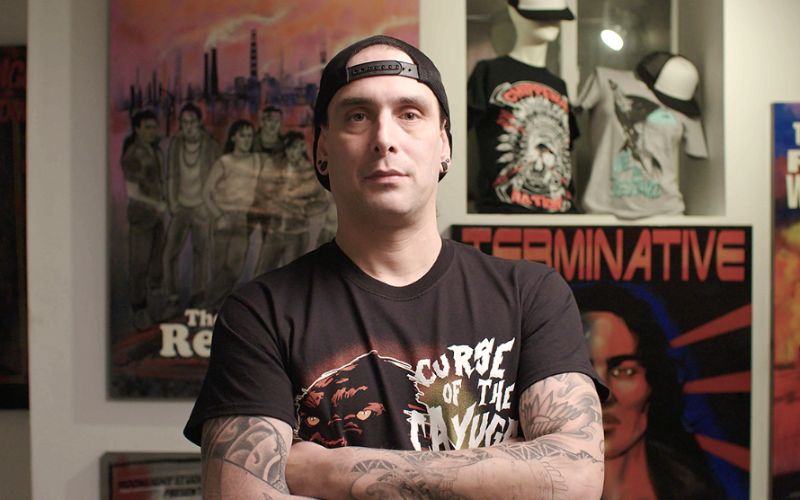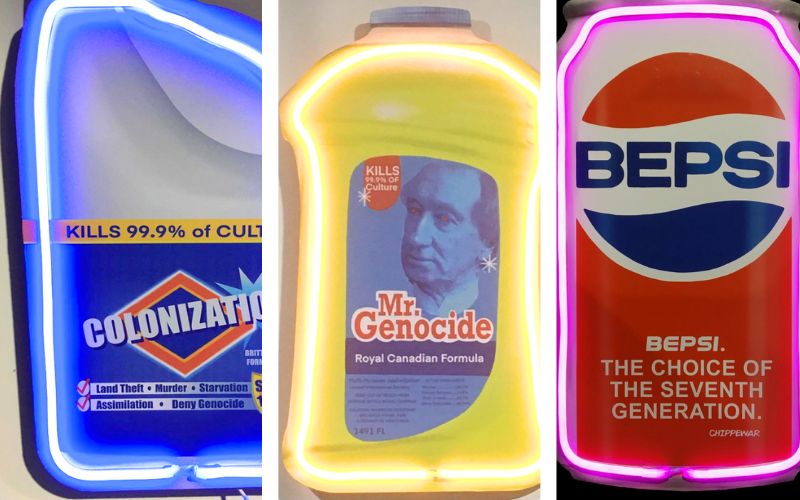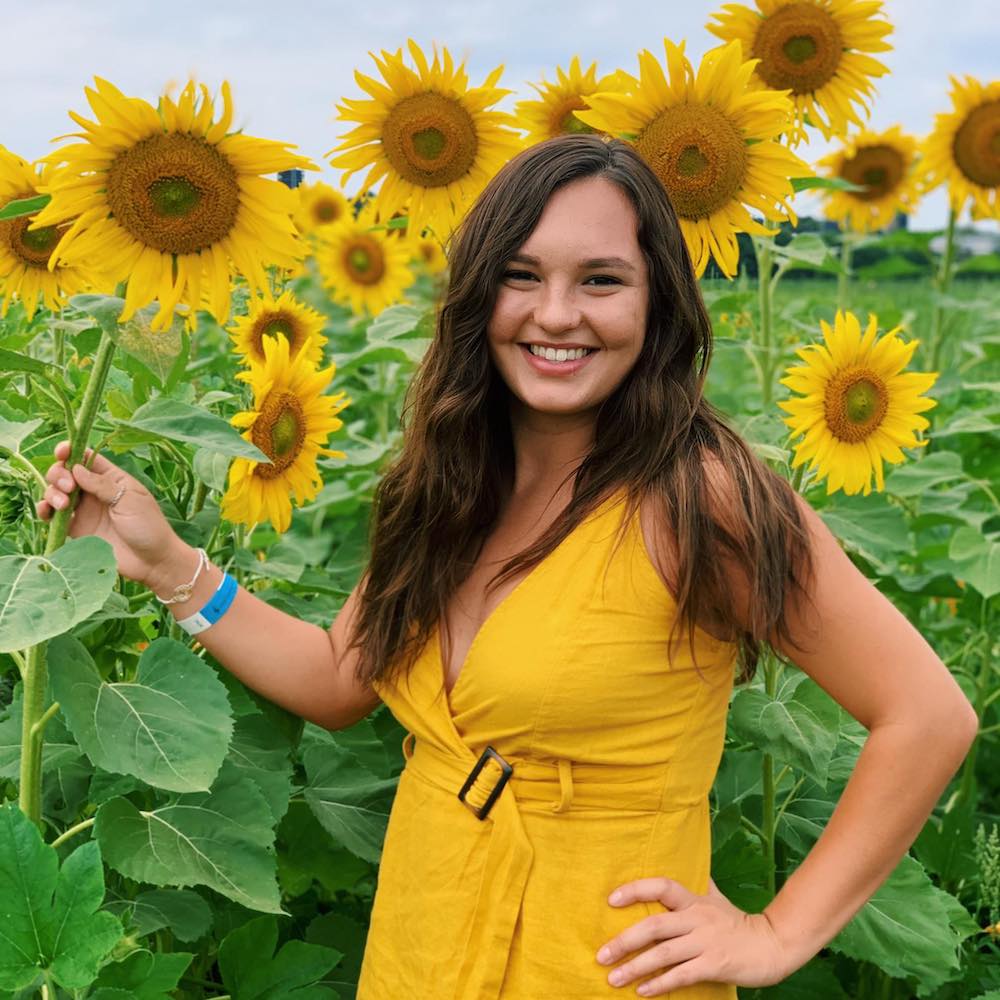
- Details
- By Kaili Berg
Soule (Chippewas of the Thames First Nation) was a professional body piercer and tattoo artist for about 15 years, working in shops across the world. He now juggles various artistic endeavors, painting, sculpting, installations, music, and his clothing line, CHIPPEWAR.
During the spring to fall seasons, you can catch him on the powwow trail, traveling to various powwows across the United States and Canada to sell his art, clothing, and other merchandise.
Soule recently talked to Native News Online about his transition from tattooing and body piercing to multimedia work sparked by the Idle No More movement — an Indigenous-led social and environmental justice movement, his creative process, and what advice he would give to aspiring Native artists.
What inspired you to become an artist?
I worked as a body piercer and tattoo artist for about 15 years before I shifted my focus to artwork around 2012. This change was influenced by the emergence of the Idle No More movement, which inspired me to contribute to sharing messages from the Indigenous community through my art.
What are you looking forward to the most by having your art showcased alongside other local artists at the Artist Project?
For the Artist’s Project, I won’t be emphasizing sales pitches. It’ll simply showcase my paintings and the neon signs I create. I’ve taken on this space mainly to expose my work to potentially thousands of people. This isn’t my first time participating; it’s probably my third or fourth. Honestly, it’s never been financially rewarding—I usually end up losing money. However, I see it as a chance to promote and market my work rather than focusing on sales. My art, which blends Indigenous themes with pop culture, might not always find the right market here. Still, I attend to make connections, meet new people, and network with fellow artists. That’s what matters to me more than just selling my work.
Can you tell us about any specific pieces or collections you’ll be showcasing at the Artist Project and what inspired them?
I’ll be displaying nine of my neon signs from a series I call ‘Max Versus.’ They’re inspired by the old Mad Magazine spoofs on products. For example, I’ve taken a product like Mr. Clean and changed it to ‘Mr. Genocide Magic Eraser,’ featuring Johnny McDonald. Another sign is a spoof on a Canadian Dry soda can, titled ‘Caniduh Lies,’ renamed ‘Ginger Tails.’ There’s also ‘Chief Rezardee,’ a play on Chef Boyardee, featuring a canned moose stew. In total, there are nine of these neon signs. Additionally, I’ll be showcasing a variety of skateboards and my movie poster works. For instance, ‘They Lie’ and ‘Indian Boy in the Temple of Doom’ highlight the residential school system and the Catholic Church’s impact on Indigenous children. The exhibition will include larger paintings, neon signs, and skateboard artwork.
Could you share some insights into the creative process behind your artwork and clothing designs?
All of my work is based on pop culture references. Growing up in a non-Indigenous home, I spent my time watching TV and watching movies and listening to music. I didn’t know much about my culture or where I came from initially. As I started learning and reconnecting, I found a way to incorporate Indigenous themes into pop culture references. It became a means of Indigenizing what I knew about pop culture while also addressing the lack of Indigenous representation and the misrepresentation in film and television. I also grew up skateboarding, reading Mad Magazine, and watching various movies, so my work is a combination of all those influences.
 Soule's neon sign series, 'Max Versus, ' imbues recognizable products with a narrative twist. (photos/Instagram)
Soule's neon sign series, 'Max Versus, ' imbues recognizable products with a narrative twist. (photos/Instagram)
What challenges have you faced as an Indigenous artist navigating the art world, and how have you overcome them?
The biggest challenge for any Indigenous artist is that we earn 30 to 40 percent less than non-Indigenous artists in Canada. The art market here tends to favor traditional Indigenous art, creating closed spaces for Indigenous artists. When opportunities do arise, they often expect traditional Indigenous art, which doesn’t align with my pop culture and pop art style. This has made it difficult for me to fit into their expectations. Curators, museums, and galleries struggle with defining what traditional Indigenous art looks like. It’s been a significant challenge. Most of my progress has come from my own initiative—about 90 percent of it involves me opening doors for myself or self-producing.
Can you share any upcoming projects or exhibitions you’re particularly excited about after the Artist Project?
I have two upcoming exhibitions. One begins later this month, towards the last week of April, at Museum London in London, Ontario. They’ll be displaying 14 of my movie poster paintings in the museum. Then, on June 14th, in Quebec City, my buffalo skulls exhibition returns. This time, it’ll be indoors, set up in the basement of a 200-year-old brick or stone building in Old Quebec City. It’ll be quite interesting to set up all those skulls and images in that space. It’s fun and exciting to see this exhibition in a different setting. I’ll be figuring it out as I go, as I’ve never even been in space until I set it up.
What advice would you give to aspiring Indigenous artists?
Just do it. Follow your instincts and create the artwork you’re drawn to. Be original with your ideas, put new spins on things, and just go for it. Don’t let anything hold you back from pursuing your art.
More Stories Like This
Zuni Youth Enrichment Project Takes Top Emerging Artist Apprentices to Phoenix for Artistic Exploration and Cultural ImmersionFrom Dishwasher to Award-Winning Chef: Laguna Pueblo's Josh Aragon Serves Up Albuquerque's Best Green Chile Stew
Rob Reiner's Final Work as Producer Appears to Address MMIP Crisis
Vision Maker Media Honors MacDonald Siblings With 2025 Frank Blythe Award
First Tribally Owned Gallery in Tulsa Debuts ‘Mvskokvlke: Road of Strength’
Help us defend tribal sovereignty.
At Native News Online, our mission is rooted in telling the stories that strengthen sovereignty and uplift Indigenous voices — not just at year’s end, but every single day.
Because of your generosity last year, we were able to keep our reporters on the ground in tribal communities, at national gatherings and in the halls of Congress — covering the issues that matter most to Indian Country: sovereignty, culture, education, health and economic opportunity.
That support sustained us through a tough year in 2025. Now, as we look to the year ahead, we need your help right now to ensure warrior journalism remains strong — reporting that defends tribal sovereignty, amplifies Native truth, and holds power accountable.
 The stakes couldn't be higher. Your support keeps Native voices heard, Native stories told and Native sovereignty defended.
The stakes couldn't be higher. Your support keeps Native voices heard, Native stories told and Native sovereignty defended.
Stand with Warrior Journalism today.
Levi Rickert (Potawatomi), Editor & Publisher


